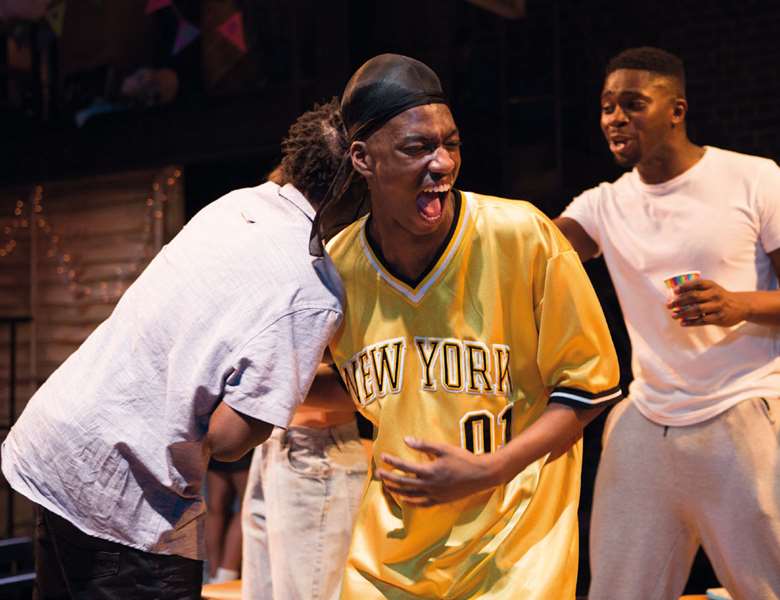Play for performance: Three
Anna Niland
Friday, May 1, 2020
Each issue of D&T we bring you a page-to-stage focus on a play for performance with your students. This issue, NYT associate director Anna Niland gives tips on mounting a production of Three

ELLIE KURTTZ
In 2016, the National Youth Theatre commissioned Sophie Ellerby to write a new play for our flagship social inclusion course Playing Up. Playing Up is a Level 3 qualification in Theatre Arts and is aimed at working with young people who are NEET (not in education, employment or training) and for whatever reason have fallen out of formal education earlier on in their life.
The process of creating Three was part of this accredited course. Sophie and I, as the director, worked collaboratively with the twenty students to develop a piece with their voices at the very heart of it. The research and development took place over a six-month period, ten days of R&D with the students and then into full time rehearsals, leading to a production at the Arcola Theatre, London, in June 2017. This collaborative approach of developing the play gave real autonomy to the students, allowing them to work closely with the writer to draw out what they were particularly interested in exploring. The luxury and privilege of working closely with a living writer meant the work felt relevant and truly theirs.
During this period and throughout the rehearsals and performance of Three, the UK (and the wider world) was experiencing a series of terror attacks – the Manchester Arena bombing in May 2017, and the London Bridge attack and Finsbury Park Mosque attack in June 2017. The play deals with this specific theme of terror threats, so the impact during the rehearsals was palpable. There became a momentum to tell a story that wasn't directly political but could somehow look at the stories that were not being told in the media, the impact on the lives of the people that we never hear about: the family of the terrorists themselves.
The play follows three sisters facing their dad's release from prison. It deals with themes of grief, inherited shame and the ripple effects of violence. In the programme notes, Sophie Ellerby wrote the following:
‘It is not a simple situation we face, it's one that has been fuelled from centuries of hatred and violence from all sides. The mainstream media, Nigel Farage, Theresa May and the like want us to believe it is simple, us and them, good and bad, black and white but what about the people caught in the crossfire from both sides. During the play there will be a minute's silence. I ask for you to take the time to remember all the innocent lives lost in the recent attacks, as well as the innocent lives lost across seas in this war we are now unfortunately all a part of. We are all human. We must fight this war with love.’
A large company of actors can seem daunting at first, but with this play the number of people on stage gives a real energy to the piece. An example of this is the opening scene of the play, a barbecue at the sisters’ home. It is a real gift of a scene, albeit challenging to realise, as the dialogue overlaps and many characters enter and exit. It feels somehow like a TV script initially, and the challenge is how to focus the audience's attention on the characters you want them to be listening to. We spent a long time on this scene in rehearsal. We honoured the brilliant vernacular dialogue, but having played around with tempo and movement we ultimately took the decision to block this scene like a piece of dance, with every character given a specific track through the scene. Each actor knew their route and this created a real dynamic energy.
We wanted the audience to arrive into this energy, so as they entered the space, the company was in full party mode, dancing to a live DJ who was placed above the actors on a platform. This DJ then performed throughout the play, underscoring the transitions and also creating sound effects, all live.
The set design was also crucial in creating the immersive atmosphere. We wanted the audience to feel completely involved so Kate Lane, our designer, created acting spaces on platforms within the auditorium. This gave the audience a feeling of spying on the characters as well as perhaps feeling more responsible for some of the choices the characters made. Staging options such as thrust or in-the-round would work well for this play.
Three by Sophie Ellerby is a brilliant play to work on with a large, young company. It offers huge scope in terms of acting skills for a young performer and the subject matter offers a real depth of discussion for the group. It is a piece that feels relevant for young audiences, and a truly powerful work.

